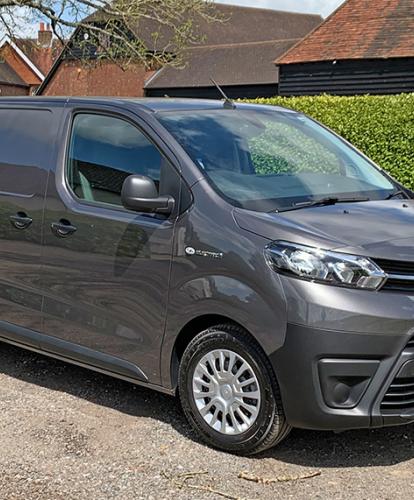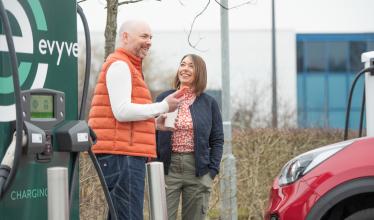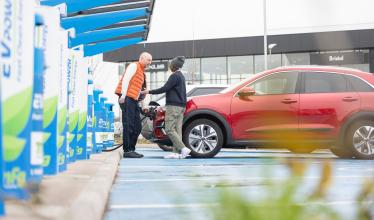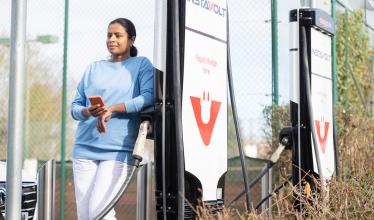Zapmap verdict: “Toyota’s first production pure-EV is a van, arriving in the shape of the Proace Electric. With a pick between two battery sizes, both offer a good range on a charge, all with the benefit of a normal load area and weight limit.”

- ● OTR: £39,338 (75 kWh tested)
- ● Category: Mid-sized LCV
- ● Tax: £0 VED
- ● Cost to charge: £12.00
- ● Emissions: 0 g/km CO2
- ● Cost per mile of range: £192
Toyota Proace Electric: Range & charging

Sharing a platform and powertrain with Stellantis Group models – Vauxhall / Citroen / Peugeot – the Proace Electric has a choice between two battery options. Both can be charged at up to 100 kW DC, and there’s an 11 kW AC on-board option available, boosting the standard 7.4 kW set-up.
There are two configurations available:
-
- ● Toyota Proace Electric 50 kWh – 100 kW – 50 kWh – 142 miles
- ● Toyota Proace Electric 75 kWh – 100 kW – 75 kWh – 205 miles
Range
The official WLTP driving range for the Toyota Proace Electric is as good as 205 miles on a charge, for the 75 kWh version at least. The 50 kWh model’s official range is 142 miles on a charge.
Although unable to push the range figures on the launch test drive, the range holds up well – at least in clement weather and with no load in the rear. The test route had a good mix of roads, and covered around 50 miles with less than 25% charge used. This means a calculated range of about 195 miles on a charge, which is very close to the official figure. Granted, most drivers will be carrying things in the cargo area, which will affect range, but it’s still far more than drivers will get from rivals like Mercedes Benz and Volkswagen.
Braking
Toyota’s electric van has two settings – D and B – with both providing some levels of brake energy recuperation. As usual, B gives stronger regen levels, but even this isn’t as much as found on other EVs. ‘One-pedal’ driving is not possible on the Proace Electric, but the braking strength in B needs to be tested a little more. It could just be that the charge never dropped below three-quarters during the test, and that braking strength will increase as charge is further depleted, but it needs further testing. However, as mentioned above, the system clearly works well considering the range available.
Charging
Charging is possible at up to 7.4 kW on AC charge points as standard. Toyota also offers an 11 kW on-board charger for those that can make the most of higher-powered chargers. Rapid charging can be carried out at 100 kW DC, with all charging settings available for both 50 kWh and 75kWh models. Charging times will take about half an hour on ultra-rapid points for the 50 kWh model, or just over 45 minutes for the larger battery model.
The Toyota Proace Electric on the road

Power comes from a 100 kW electric motor, which has three different settings to alter output. Eco sees power restricted to 60 kW, Normal has 80 kW available to the driver, and the full 100 kW is available in Power. In Power mode for the 75 kWh model, the 0-62 mph time is 13.3 seconds – with the 50 kWh version taking a little over a second less. Pace is excellent at lower speeds, and the responsiveness in urban areas is ideally suited to delivery drivers. It’s comfortable at higher speeds, but works best on twister roads or city streets.
What’s the Toyota Proace Electric like to drive?
Handling is good for the class, thanks in part to the large battery placed in the floor of the Proace Electric. It drops the centre of gravity, and effectively ‘adds load’ when compared to diesel models, instantly improving the ride and handling. It’s both comfortable and easy to drive, key attributes for fleets and business drivers.
Toyota Proace Electric: Comfort & Practicality

Seating is comfortable for two, with a third possible in a central seat. That central pew doesn’t have much leg space, because of the centre console, but it’s no worse than many in its class. There is a little more space than normal because there’s no gear stick, instead a rocker switch to select drive, flanked by a drive mode selector and a B button for increased brake energy recuperation. Space for the driver and outside passenger is good though, and there’s plenty of space for bits and pieces, plus a workspace that folds down from the middle seat back.
Design and functionality
Switchgear and materials used feel robust, and as good as you would expect from the mid-range van. Rivals from Mercedes Benz and Volkswagen have nicer interiors, but also lack driving range in comparison. There’s a compact touchscreen infotainment system that’s easy to use, and includes Apple CarPlay/Android Auto connectivity. Payload is slightly affected by the battery, but remains at around the one tonne mark, and load capacity is unchanged at 5.3 cubic meters.
Toyota Proace Electric: Tech & Specifications

There’s only one trim level and one size chassis available, with the main choice coming down to the battery capacity. Fitted as standard are:
- 16-inch wheels
- Seven-inch infotainment display
- Apple CarPlay / Android Auto connectivity
- Automatic wipers
- Rear parking sensors
- Twin sliding panel doors
Toyota’s main competitors come from the shared models from Vauxhall, Peugeot, and Citroen. They offer similar ranges, and some additional options in terms of size and load capacity. Other than that, the Proace Electric has a significant driving range advantage over other rivals, which will make a difference to many drivers. The Proace Electric is a great van for local runs, but also has the range and charging capabilities to be used as a long-distance runner. Comfortable and simple to drive, for all but the longest-distance drivers, the Toyota Proace is a better van as an EV than a diesel.
And how much is the road tax on a Toyota Proace Electric? Use our Car Tax Calculator to find out.
All information above correct at time of publication. Official economy figures, pricing, and tax rates supplied by the manufacturer. Cost to charge based on 0-100% charge at home on a tariff of 16 p/kWh.



